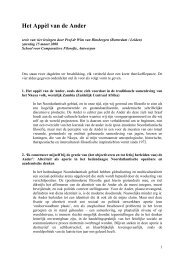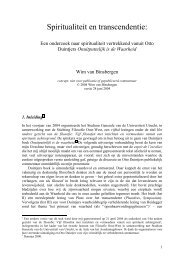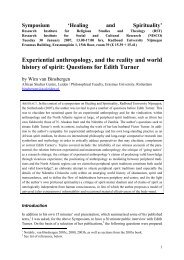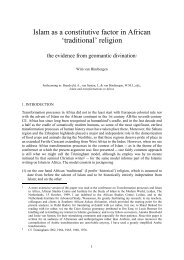Izanami giving birth to Kagutsuchi / Fire - Shikanda.net
Izanami giving birth to Kagutsuchi / Fire - Shikanda.net
Izanami giving birth to Kagutsuchi / Fire - Shikanda.net
Create successful ePaper yourself
Turn your PDF publications into a flip-book with our unique Google optimized e-Paper software.
1. Introduction<br />
1.1. Synopsis of the myth of Giving Birth <strong>to</strong> <strong>Kagutsuchi</strong> / <strong>Fire</strong><br />
Point of departure of my argument is the myth of the Japanese goddess <strong>Izanami</strong><br />
(イザナミ, also given as 伊弉冉尊 or 伊邪那美命, meaning ‘she who invites’)<br />
<strong>giving</strong> <strong>birth</strong> <strong>to</strong> the <strong>Fire</strong> God <strong>Kagutsuchi</strong> (カグツチ), also called <strong>Kagutsuchi</strong> no kami<br />
(迦具土の神), Hinokagutsuchi (火之迦具土), or Ho musuhi (火産霊). <strong>Izanami</strong> is the<br />
sister and spouse of Izanagi (イザナギ, recorded in Japanese classic his<strong>to</strong>ries (early<br />
8 th c. CE) as 伊弉諾 – in the Kojiki 古事記 – or as 伊邪那岐 – in the Nihon Shoki or<br />
Nihongi –, also written as 伊弉諾尊, meaning ‘he who invites’). These two creation<br />
deities of the eighth generation have, geomythically, produced the islands, sea, rivers,<br />
mountains, trees, herbs, of the Japanese archipelago. Although many instances of<br />
procreation in the early phase of the ‘Age of the Gods’ are indirect and non-genital –<br />
with numerous clusters of gods springing from implements, acts, conditions etc.), the<br />
earliest geomythical phase of this process is implied <strong>to</strong> have taken place in the normal<br />
manner of human <strong>birth</strong>, from <strong>Izanami</strong>’s womb and via the natural <strong>birth</strong> channel<br />
(which marks her as a great Mother Goddess). Yet, amazingly enough, considering<br />
the diverse nature of this offspring, no obstetric problems presented themselves (apart<br />
from some highly significant miscreants <strong>to</strong> which we shall return) until <strong>Izanami</strong> gives<br />
<strong>birth</strong> <strong>to</strong> <strong>Kagutsuchi</strong> / <strong>Fire</strong>. Then (at least, according <strong>to</strong> the Kojiki, and one alternative<br />
version cited in the Nihongi) her genitals are lethally burnt, and she retreats <strong>to</strong> Yomi<br />
黄泉 / ‘Yellow Springs’, the land of death, where her dealings with Izanagi constitute<br />
a dramatic and moving parallel <strong>to</strong> the Orpheus and Eurydice theme from Ancient<br />
Graeco-Roman mythology. 2 Fleeing from Yomi and pursued by <strong>Izanami</strong> and the eight<br />
Thunder gods that have sprung from her putrefying body, Izanagi erects a number of<br />
boundaries between Yomi and the land of the living, separates from <strong>Izanami</strong> who thus<br />
become the Death goddess, kills <strong>Kagutsuchi</strong> / <strong>Fire</strong>, and engages in elaborate purifica<strong>to</strong>ry<br />
lustration, – in the process all the while generating new clusters of gods, including<br />
the two protagonists of the next mythical episode: the Ocean/rains<strong>to</strong>rm god<br />
Susanowo スサノオ, and his sister the Sun goddess Amaterasu-ōmikami<br />
(天照大神/天照大御神) or Ōhiru-menomuchi-no-kami (大日孁貴神).<br />
1.2. Central question and disclaimer<br />
My argument seeks <strong>to</strong> answer the central question as <strong>to</strong> why, after <strong>giving</strong> <strong>birth</strong> <strong>to</strong><br />
islands, mountains, rivers and trees for which the human womb and the human natural<br />
<strong>birth</strong> channel are equally unequipped, <strong>giving</strong> <strong>birth</strong> <strong>to</strong> <strong>Kagutsuchi</strong> / <strong>Fire</strong> should be<br />
so utterly disruptive, both <strong>to</strong> <strong>Izanami</strong> and her sibling spouse, and <strong>to</strong> the narrative<br />
sequence of the canonical Japanese cosmogony.<br />
2 Cf. Ovid., Metamorphoses 10; Apollodorus, Bibliotheke, 1.3.2; Pausanias, 9.30; Vergil., Georgica,<br />
4.453.<br />
4
















